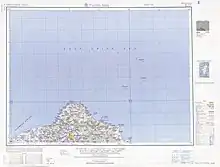Tʻai-pei
English

Map including TʻAI-PEI SHIH (TAIHOKU) 台北市) (AMS, 1950)
Etymology
From the Wade–Giles romanization of the Mandarin Chinese pronunciation for 臺北/台北 (Tʻai²-pei³).[1]
Proper noun
Tʻai-pei
- Alternative spelling of Taipei
- 1953, Norton S. Ginsburg, The Economic Resources and Development of Formosa, Institute of Pacific Relations, page 4:
- Although all of the island receives 40 inches of rainfall a year, except for a very narrow strip along the west coast, precipitation is seasonally and locally variable. Most of it falls between May and September, except in the northeast where 60-100 inches is fairly well distributed throughout the year. Here the prevailing winds are northerly and northeasterly and bring rain to T'ai-pei and I-lan hsien.
- 1974, D. E. H. Russell, Rebellion, Revolution, and Armed Force, Academic Press, →ISBN Invalid ISBN, page 111:
- On Dec. 8, 1949, T'ai-pei, on the island of Formosa, to which Chiang Kai-shek and many of his followers had fled, was declared the Nationalist Capital.
- 2000, Field, Cathering, China (Nations of the World), Raintree Steck-Vaughn, →ISBN, →LCCN, →OCLC, page 23:
- After the communists came to power on the Chinese mainland in 1949, the nationalists fled to the island and set up a rival government of China in T'ai-pei.
- 2006, Philip Dodd, Ben Donald, The Book of Cities, New York (printed in China): MJF Books, →ISBN, page 236:
- "T’ai-pei is still as Chinese as a spring roll - with barbecue sauce on top." - Peter Biddlecombe
-
Translations
Taipei — see Taipei
References
- Taipei, Chinese (Wade-Giles romanization) T’ai-pei, in Encyclopædia Britannica
Further reading
- “T'ai-pei” in TheFreeDictionary.com, Huntingdon Valley, Pa.: Farlex, Inc., 2003–2023.
This article is issued from Wiktionary. The text is licensed under Creative Commons - Attribution - Sharealike. Additional terms may apply for the media files.